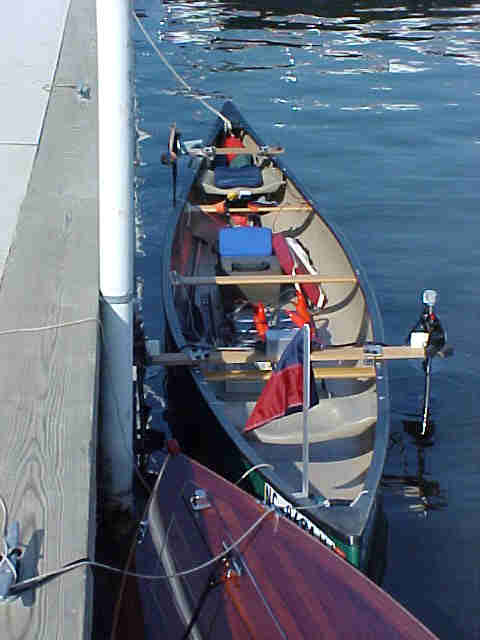eCanoe Places Third in Wye Island Race 2004
Jim Campbell
A new motor design propelled the eCanoe entry to third place in the 24-mile Wye Island Race in St. Michaels, Maryland this year. Using a custom 24-volt, single motor PWM speed controller driving two 12V motors in series, the 20-foot Old Town XL Tripper completed the 24-mile course with an average speed of 5.07 MPH over 22.8 miles GPS. Because a canoe can safely cut the corners around the island, actual GPS mileage traveled was less than the buoyed course. The corner-cutting was fraught with dangers this year, however, due to debris in the water from recent storms, prop drag on the muddy bottom, and the occasional fishing vessel. A heavy cross-wind on the 4-mile final leg back to the finish also created difficulty, as I had to head into the wind at a suitable angle to prevent heavy side-splash. I was way out in the main boat channel before I could angle downwind. Just then a HUGE yacht cruised in behind me, trailing a wake large enough to surf. It sure was good to motor in to the docks and stop rocking.
Power supply consisted of eight 55AH sealed lead-acid batteries (39 lb, ea = 312 lb). Four batteries were used in series-parallel until getting low about ten miles out. The clamp wiring was then moved to the remaining cells. At about 17 miles, the speed was dropped to 4.5MPH to preserve the remaining charge for a longer-than-expected route. Slowing the canoe also decreases splash considerably. Ideally, it is best to head directly upwind for least splash into a canoe (the "E"-flag in the bow makes a perfect wind vane for this), but that would have taken me way off course. The slower speed allowed a safe crosswind tack, with definite savings in total course time.
 Back
at the Miles River Yacht Club, I lost no time in tying the eCanoe out and
setting up the rechargers using the club's dock power. No need to unload
the batteries for recharging here. The two splash-proof plastic tool boxes
holding the eight 3-Amp/2-stage charging modules are barely visible in this
photo. The batteries were ready for the maritime Museum Boat Show in the
morning. Note the motor position - out of the water and facing down to
shed any salt splash. This extends their life greatly, whether "Salt-Water
qualified" or not.
Back
at the Miles River Yacht Club, I lost no time in tying the eCanoe out and
setting up the rechargers using the club's dock power. No need to unload
the batteries for recharging here. The two splash-proof plastic tool boxes
holding the eight 3-Amp/2-stage charging modules are barely visible in this
photo. The batteries were ready for the maritime Museum Boat Show in the
morning. Note the motor position - out of the water and facing down to
shed any salt splash. This extends their life greatly, whether "Salt-Water
qualified" or not.
With all in order, it was time to spruce up for the dinner that night. The club was able to sit us all at one table this year, which made for a lively and fun time for all.
This year's eCanoe "E"-flag Award for the most achievement in electric boating was awarded to Tom Hesselink of Budsin Boats for his commanding win in a fine new Budsin Phantom. Congratulations, Tom, display it proudly!
At the end of the day I fell into bed and drifted off to sleep to the rocking of my sea legs. A great end to a great race!
Next day, the Museum Boat Show was crowded by the time I got there, so I had to hunt for a place to dock. The only spot was a narrow shallow slip right next to the shore. I tied up and was immediately deluged with questions and comments. Seems I had docked right next to the tourist walk. It was late afternoon before I cruised back to the Yacht Club and loaded the canoe back on the van. I would be in Chincoteague, VA that night for an e-cruise out into the ocean on Sunday. Monday night the boat, motors, batteries, and pilot were all home - washed and put up for another day.
© eCanoe2005